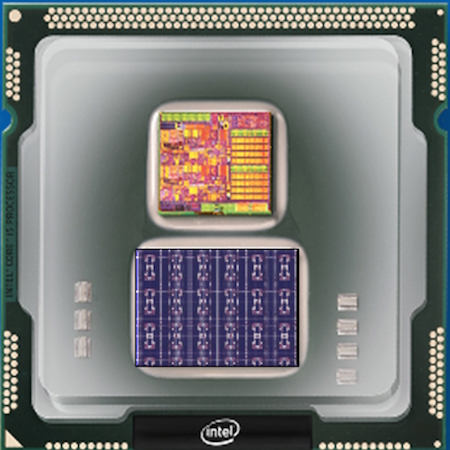Science Fiction
Dictionary
A B C D E F G H I J K L M N O P Q R S T U V W X Y Z
Loihi Chip Mimics Human Brain's Neurons And Synapses

Looking for a self-learning, energy-efficient neuromorphic chip? Intel's research chip codenamed "Loihi" uses 130,000 "neurons" and 130,000,000 "synapses" to mimic the functioning of the human brain.

(Loihi Intel chip)
The idea is to help computers self-organize and make decisions based on patterns and associations,” Michael Mayberry, PhD, corporate vice president and managing director of Intel Labs at Intel Corporation, explained in a blog post.He said the chip automatically gets smarter over time and doesn’t need to be trained in the traditional way. He sees applications in areas that would benefit from autonomous operation and continuous learning in an unstructured environment, such as automotive, industrial, and personal-robotics areas.
For example, a cybersecurity system could identify a breach or a hack based on an abnormality or difference in data streams. Or the chip could learn a person’s heartbeat reading under various conditions — after jogging, following a meal or before going to bed — to determine a “normal” heartbeat. The system could then continuously monitor incoming heart data to flag patterns that don’t match the “normal” pattern, and could be personalized for any user.
“Machine learning models such as deep learning have made tremendous recent advancements by using extensive training datasets to recognize objects and events. However, unless their training sets have specifically accounted for a particular element, situation or circumstance, these machine learning systems do not generalize well,” Mayberry notes.
Robert Heinlein saw the need for computers and robots that could learn and adjust their behavior; he described Flexible Frank in his 1956 novel The Door Into Summer. This robot had Thorsen memory tubes to allow it to learn by doing.
...the point is that you can hook a Thorsen tube into a control circuit, direct the machine through an operation by manual control, and the tube will "remember" what was done and can direct the operation without a human supervisor a second time, or any number of times.
(Read more about Thorsen memory tubes)
Other examples of science-fictional computer "brains" includes the Laminated Mouse Brain Computer from Think Blue, Count Two (1962) by Cordwainer Smith, the neuristor from The Moon is a Harsh Mistress (1966) by Heinlein and the artificial brain from The Metal Giants (1926) by Edmond Hamilton.
Via KurzweilAI
Scroll down for more stories in the same category. (Story submitted 10/14/2017)
Follow this kind of news @Technovelgy.| Email | RSS | Blog It | Stumble | del.icio.us | Digg | Reddit |
Would
you like to contribute a story tip?
It's easy:
Get the URL of the story, and the related sf author, and add
it here.
Comment/Join discussion ( 0 )
Related News Stories - (" Computer ")
Is Agentic AI The Wrong Kind Of Smartness?
'It’s smart enough to go wrong in very complicated ways, but not smart enough to help us find out what’s wrong.' - Isaac Asimov, 1975.
Jetson Orin Nano Super 70 Just $249
'Rayno folded up the microterm and tucked it back inside his jumper.' - Bruce Bethke, 1983.
Automatic Bot Traffic Is 38 Percent Of HTTP Requests
'there were so many worms and counterworms loose in the data-net...' - John Brunner, 1975
Neuroplatform Human Brain Organoid Bioprocessor Uses Less Electricity
'Cultured brains on a slab.'- Peter Watts, 1999
Technovelgy (that's tech-novel-gee!) is devoted to the creative science inventions and ideas of sf authors. Look for the Invention Category that interests you, the Glossary, the Invention Timeline, or see what's New.
Science Fiction
Timeline
1600-1899
1900-1939
1940's 1950's
1960's 1970's
1980's 1990's
2000's 2010's
Current News
Golf Ball Test Robot Wears Them Out
"The robot solemnly hit a ball against the wall, picked it up and teed it, hit it again, over and again...'
Boring Company Vegas Loop Like Asimov Said
'There was a wall ahead... It was riddled with holes that were the mouths of tunnels.'
Rigid Metallic Clothing From Science Fiction To You
'...support the interior human structure against Jupiter’s pull.'
Is The Seattle Ultrasonics C-200 A Heinlein Vibroblade?
'It ain't a vibroblade. It's steel. Messy.'
Roborock Saros Z70 Is A Robot Vacuum With An Arm
'Anything larger than a BB shot it picked up and placed in a tray...'
A Beautiful Visualization Of Compact Food
'The German chemists have discovered how to supply the needed elements in compact, undiluted form...'
Bone-Building Drug Evenity Approved
'Compounds devised by the biochemists for the rapid building of bone...'
Secret Kill Switch Found In Yutong Buses
'The car faltered as the external command came to brake...'
Inmotion Electric Unicycle In Combat
'It is about the size and shape of a kitchen stool, gyro-stabilized...'
Grok Scores Best In Psychological Tests
'Try to find out how he ticks...'
PaXini Supersensitive Robot Fingers
'My fingers are not that sensitive...'
Congress Considers Automatic Emergency Braking, One Hundred Years Too Late
'The greatest problem of all was the elimination of the human element of braking together with its inevitable time lag.'
The Desert Ship Sailed In Imagination
'Across the ancient sea floor a dozen tall, blue-sailed Martian sand ships floated, like blue smoke.'
The Zapata Air Scooter Would Be Great In A Science Fiction Story
'Betty's slapdash style.'
Thermostabilized Wet Meat Product (NASA Prototype)
There are no orbiting Michelin stars. Yet.
Could Crystal Batteries Generate Power For Centuries?
'Power could be compressed thus into an inch-square cube of what looked like blue-white ice'
